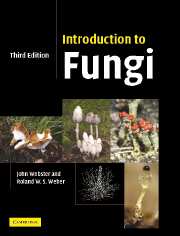Book contents
- Frontmatter
- Contents
- Preface to the first edition
- Preface to the second edition
- Preface to the third edition
- Acknowledgements
- 1 Introduction
- 2 Protozoa: Myxomycota (slime moulds)
- 3 Protozoa: Plasmodiophoromycota
- 4 Straminipila: minor fungal phyla
- 5 Straminipila: Oomycota
- 6 Chytridiomycota
- 7 Zygomycota
- 8 Ascomycota (ascomycetes)
- 9 Archiascomycetes
- 10 Hemiascomycetes
- 11 Plectomycetes
- 12 Hymenoascomycetes: Pyrenomycetes
- 13 Hymenoascomycetes: Erysiphales
- 14 Hymenoascomycetes: Pezizales (operculate discomycetes)
- 15 Hymenoascomycetes: Helotiales (inoperculate discomycetes)
- 16 Lichenized fungi (chiefly Hymenoascomycetes: Lecanorales)
- 17 Loculoascomycetes
- 18 Basidiomycota
- 19 Homobasidiomycetes
- 20 Homobasidiomycetes: gasteromycetes
- 21 Heterobasidiomycetes
- 22 Urediniomycetes: Uredinales (rust fungi)
- 23 Ustilaginomycetes: smut fungi and their allies
- 24 Basidiomycete yeasts
- 25 Anamorphic fungi (nematophagous and aquatic forms)
- References
- Index
- Plate section
20 - Homobasidiomycetes: gasteromycetes
- Frontmatter
- Contents
- Preface to the first edition
- Preface to the second edition
- Preface to the third edition
- Acknowledgements
- 1 Introduction
- 2 Protozoa: Myxomycota (slime moulds)
- 3 Protozoa: Plasmodiophoromycota
- 4 Straminipila: minor fungal phyla
- 5 Straminipila: Oomycota
- 6 Chytridiomycota
- 7 Zygomycota
- 8 Ascomycota (ascomycetes)
- 9 Archiascomycetes
- 10 Hemiascomycetes
- 11 Plectomycetes
- 12 Hymenoascomycetes: Pyrenomycetes
- 13 Hymenoascomycetes: Erysiphales
- 14 Hymenoascomycetes: Pezizales (operculate discomycetes)
- 15 Hymenoascomycetes: Helotiales (inoperculate discomycetes)
- 16 Lichenized fungi (chiefly Hymenoascomycetes: Lecanorales)
- 17 Loculoascomycetes
- 18 Basidiomycota
- 19 Homobasidiomycetes
- 20 Homobasidiomycetes: gasteromycetes
- 21 Heterobasidiomycetes
- 22 Urediniomycetes: Uredinales (rust fungi)
- 23 Ustilaginomycetes: smut fungi and their allies
- 24 Basidiomycete yeasts
- 25 Anamorphic fungi (nematophagous and aquatic forms)
- References
- Index
- Plate section
Summary
Introduction
Gasteromycetes are an unnatural assemblage of basidiomycetes sharing the common negative character that the basidiospores are not discharged violently from their basidia. Instead of the ballistosporic basidiospores of other basidiomycetes which are asymmetric in side view (see Fig. 18.5), those of the gasteromycetes are usually symmetrically poised on their sterigmata or are sessile. Dring (1973) has termed such basidiospores statismospores. Commonly the basidia open into cavities within a fruit body, and the basidiospores are released into these cavities as the tissue between them breaks down or dries out. A recognizable fertile layer (hymenium) may be present or absent (see Reijnders, 2000). The internal production of basidiospores has given the gasteromycetes their name (Gr. gaster = stomach). The gasteromycete fruit body is termed the gasterocarp, and the spore mass enclosed by the gasterocarp wall (peridium) is the gleba. Sometimes, as in Lycoperdon or Geastrum, the gasterocarp opens by a pore through which the spores escape, but in forms with subterranean (hypogeous) fruit bodies there is no special opening, and it is possible that the spores are dispersed by rodents and other burrowing animals (Colgan & Claridge, 2002). In Phallus and its allies, the basidiospores are exhibited in a sticky mass attractive to insects, whilst in Cyathus and Sphaerobolus the spores are enclosed in separate glebal masses or peridioles which are dispersed as units. In spite of these variations in gasterocarp morphology, the life cycles of most gasteromycetes follow the general Homobasidiomycete pattern outlined in Fig. 18.4.
- Type
- Chapter
- Information
- Introduction to Fungi , pp. 577 - 592Publisher: Cambridge University PressPrint publication year: 2007



